Kai Link KWL-320 Wireless Access Point User Manual KWL 320 installation guide
Kai-Link Corporation Ltd. Wireless Access Point KWL 320 installation guide
Kai Link >
Users manual

Wireless 802.11b
11Mbps Series
User’s Manual
KWL-320 Access Point
Version:A (July. 2002)

1
Warning:
Any changes or modifications not expressly approved by the
party responsible for compliance could void the authority to
operate equipment.
Caution:
1. This device complies with Part 15 of the FCC Rules.
Operation is subject to the following two conditions:
(1) this device may not cause harmful interference, and (2)
this device must accept any interference received,
including interference that may cause undesired operation.
2. To comply with FCC RF exposure compliance requirements, a
separation distance of at least 20 cm must be maintained
between the antenna of this device and all persons.
3. This Transmitter must not be co-located or operating in
conjunction with any other antenna or transmitter.

2
Content
1 Introduction................................................................................................................... 3
Key Features..................................................................................................................... 3
Applications ...................................................................................................................... 4
Package Contents ............................................................................................................. 4
2 Specifications................................................................................................................. 5
3 About W@LK LAN Access Point.................................................................................. 6
4 Installation..................................................................................................................... 7
Selecting an appropriate site for your W@LK LAN AP.............................................. 7
Connecting the W@LK LAN AP to a cable/DSL router, Ethernet switch, or hub.... 7
Using the W@LK LAN AP to expand local coverage................................................... 8
5 Before You Configuration............................................................................................. 9
6 Configuring Your W@LK LAN AP..............................................................................11
1. Password..................................................................................................................11
2. Information..............................................................................................................11
3. Associations............................................................................................................. 12
4. Wireless................................................................................................................... 13
5. Advanced................................................................................................................. 15
6. Security ................................................................................................................... 17
7. Server...................................................................................................................... 20
8. Administration....................................................................................................... 22
9. Help ......................................................................................................................... 23
7 Troubleshooting.......................................................................................................... 24

3
1 Introduction
Introduction
Thank you for purchasing the W@LK LAN 11Mbps Wireless Access Point and welcome to
the world of wireless networking. Now you can take advantage of this great new technology
and gain the freedom you need around the home or office without using cables. The
W@LK LAN AP acts as a bridge between your existing wired network and your wireless
equipped computers. The easy installation and setup will have you networking wirelessly in
minutes. Please be sure to read through this manual completely to be sure that you are
getting the most out of your W@LK LAN AP.
Key Features
Wide Area Coverage at High Speeds
The W@LK LAN AP provides coverage over an indoor area up to 300 feet in radius and an
outdoor area over 1,800 feet in radius.
Up to 128-bit Security Encryption
Your W@LK LAN AP is capable of encrypting (scrambling) the transmitted radio waves so
you can be sure that your data is secure. The optional encryption feature allows you to
encrypt at 64-bits or 128-bits using a key that you enter yourself.
MAC Address Filtering
For added security, you can set up a list of MAC addresses (unique client identifiers) that
are allowed access to your wireless network. Every computer equipped with a wireless
network adapter has its own MAC address. Simply enter these MAC addresses into a list
using the W@LK LAN Wireless 802.11b Network Manager software, and access to your
network through the W@LK LAN AP is restricted to only those MAC addresses.

4
Introduction
Applications
• Wireless roaming with a laptop around the home or office
Gain the freedom you need around the home or office with no cables.
• Difficult-to-wire environments
For use in buildings with solid or finished walls or open areas where wiring is difficult to
employ.
• Frequently Changing Environments
Offices or environments that frequently rearrange the workplace and change location.
• Temporary LANs for special projects or peak time
Trade shows, exhibitions, and construction sites that need a network on a temporary basis.
Companies that need additional workstations for a peak activity period.
• SOHO (Small Office/Home Office)
SOHO users who need easy and quick setup.
Package Contents
• W@LK LAN Wireless Network Access Point
• Power Adapter
• User Manual
• Cross Cable
System Requirements
• At least one computer equipped with an 802.11b compliant wireless Ethernet adapter
• TCP/IP networking protocol installed on each computer

5
Product Specifications
2 Specifications
Technical Specification
Standards IEEE 802.11b for Wireless LAN
IEEE 802.3 for Wired LAN
Ports RJ-45, 10 BASE-T
POWER 5V DC 1A
Management Utility Web Base Management
Transport Protocols TCP/IP
IPX/SPX
NetBEUI
BOOTP
SNMP
Telnet
DHCP
FTP
Data Security 64/128-bit WEP (Wired Equivalent Privacy)
Encryption
Frequency Range 2.4GHz-2.4835GHz ISM Band
Modulation Direct Sequence Spread Spectrum ( DSSS )
Data Rate and Modulation @1Mbps - DBPSK
@2Mbps – DQPSK
@5Mbps – CCK
@11Mbps - CCK
Reception Sensitivity @1Mbps -89.0 dBm, 8% PER
@5.5Mbps -87.0 dBm, 8% PER
@11Mbps -82.0 dBm, 8% PER
Transmit Power +15dBm typical
Antenna One External 2dB gain antenna
Operating Modes 11 Channels (US, Canada)
13 Channels (Europe)
14 Channels (Japan)
LED Indicators Power (RED)
Link (Green)
TX/RX(Green)
Temperature Operating Temperature: 0°C to 55°C
Certification FCC
CE
Safety UL
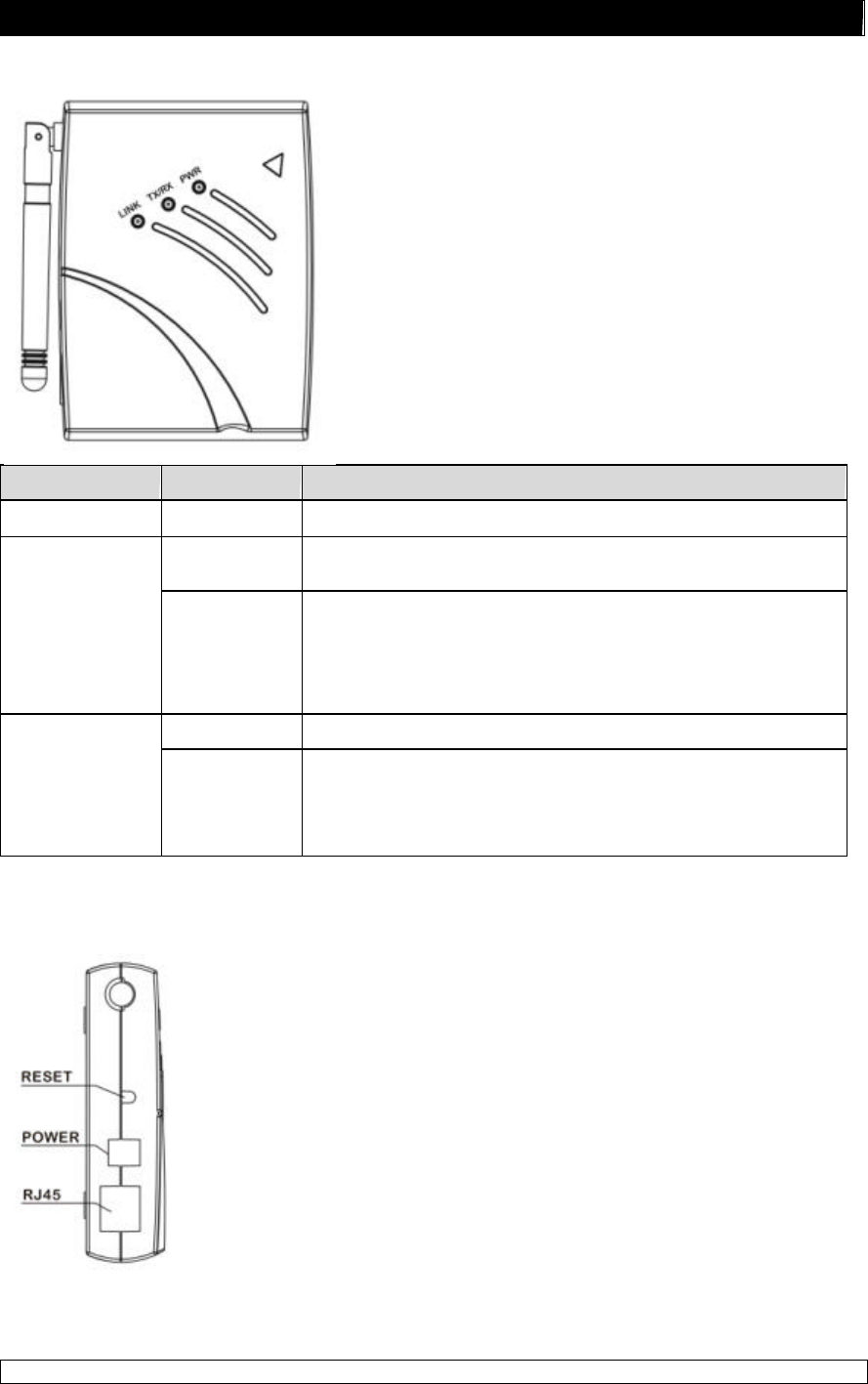
6
3 About W@LK LAN Access Point
LED Indicators
The Wireless Access Point includes three status LED
indicators, as described in the following figure and
table.
LED Status Description
Power (Red) On Indicates the power is being supplied
On Indicates a valid wireless link.
TX/RX
Wireless
Link/Activity
(Green)
Flashing Indicates that the Access Point is transmitting or
receiving data on the Wireless LAN. Blinking rate is
proportional to your network activity.
On Indicates a valid 10Mbps Ethernet cable link.
LINK
Ethernet
Link/Activity
(Green)
Flashing Indicates that the Access Point is transmitting or
receiving data on the 10Mbps Ethernet LAN. Blinking
rate is proportional to your network activity.
Reset
Restore to the default numeric.
Power Jack
Connect the 5V DC connector from the power supply to this jack.
RJ45 Ethernet Jack
For Connection: See the Installation in this manual.

7
Quick Setup
4 Installation
Selecting an appropriate site for your W@LK LAN AP
Selecting an appropriate site for your W@LK LAN AP will ensure the best performance.
First, a few rules of thumb:
• Avoid locating the W@LK LAN AP near metal objects such as appliances like
refrigerators, ovens, and washer/dryers. Keep in mind that your appliances may be on the
other side of the wall in the area that you may be considering to locate the W@LK LAN AP.
• For best performance, locate the W@LK LAN AP as close to the center of the area that
you will be covering. Keep in mind that radio waves radiate outward from the W@LK LAN
AP in a circular pattern. Typical range is 100-150 feet indoors at 11Mbps. If the area you
wish to cover is smaller than 200-300 feet wide, then locating the W@LK LAN AP in the
center of the area becomes less critical.
• Normally, the higher that you locate the W@LK LAN AP, the better the performance and
range will be. However, in an area such as an average-sized house or small office, height is
less critical.
• Remember that many things can cause a degrade of the radio signal such as brick walls,
metal-reinforced concrete, the metal housing of appliances, or even wiring in the walls.
Connecting the W@LK LAN AP to a cable/DSL router, Ethernet switch, or hub
Select a suitable site for your W@LK LAN AP.
Connect a CAT5 cable between the W@LK LAN AP and your cable/DSL router’s LAN port,
Ethernet switch, or hub by plugging one end of the cable into the RJ45 jack on the W@LK
LAN AP and the other end into an open RJ45 jack on the cable/DSL router, Ethernet switch,
or hub.
Connect the power supply to the W@LK LAN AP by plugging the round DC connector into
the DC jack on the W@LK LAN AP. Plug the power supply into the wall. Verify that the
Power LED and the Link LED are illuminated. If both LEDs are illuminated, this indicates
that the W@LK LAN AP is connected properly.
Place the W@LK LAN AP on a desktop or mount it to a wall in the location that you have
chosen. Next, swivel the antennas so they are both pointing up.
Installation
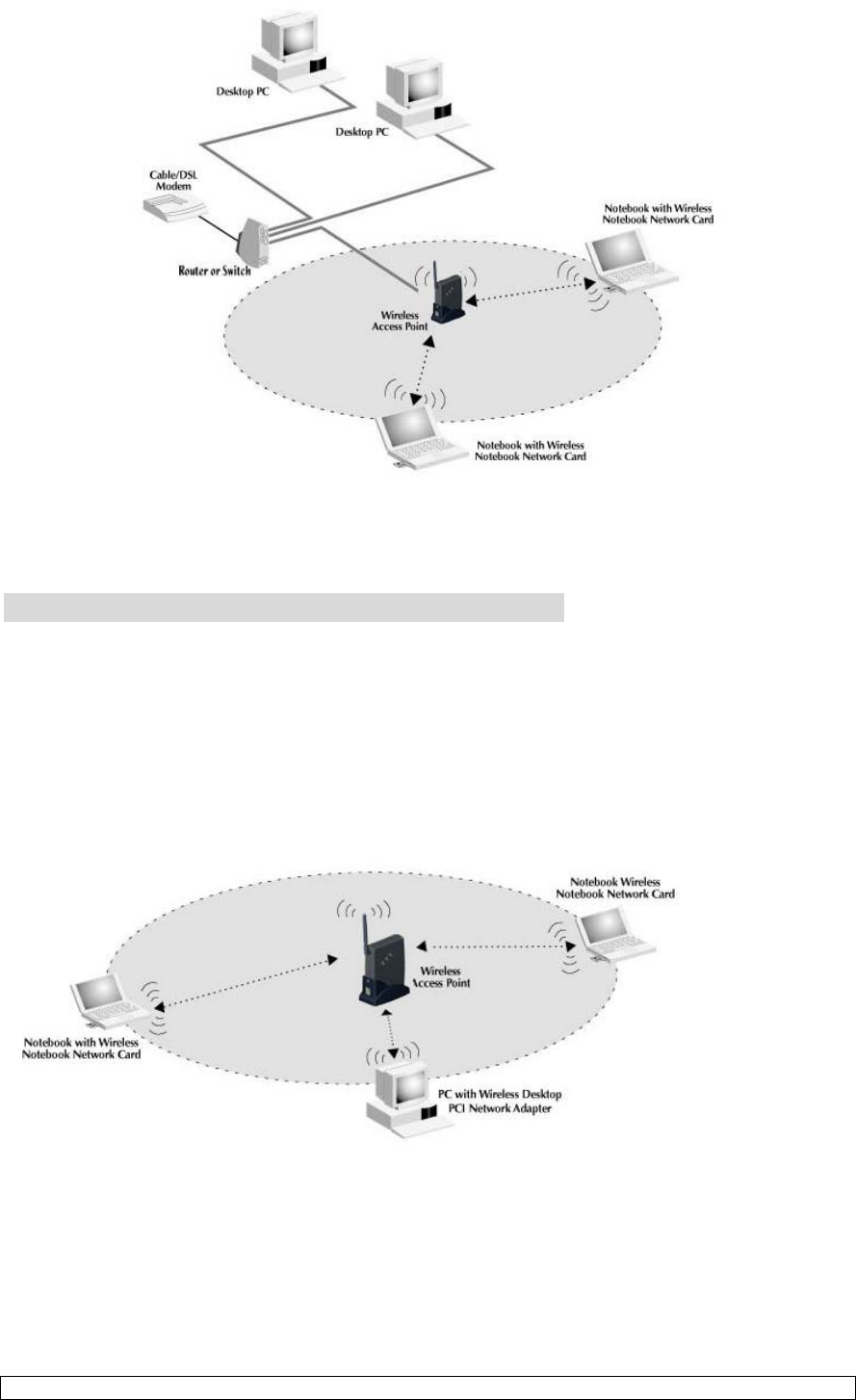
8
Installation
Using the W@LK LAN AP to expand local coverage
The W@LK LAN AP can act as a central point of communication of your wireless-equipped
computers without connecting it to a wired network. Using the W@LK LAN AP in this
manner will effectively double the range between your wireless-equipped computers by
relaying the data from one computer to another. Simply locate the W@LK LAN AP in the
center of the area you will be operating your network. The diagram below illustrates this
concept.

9
5 Before You Configuration
The W@LK LAN offers a platform-independent, HTML-based GUI (graphical user interface)
to simplify the setup and configuration of your W@LK LAN using your PC’s web browser.
Before you start configuring your W@LK LAN, you must connect cross cable between your
PC and W@LK LAN AP.
Configure your PC’s TCP/.IP on the network adapter, either an Ethernet or a Wireless
Adapter, that you use to connect to your PC to the W@LK LAN. Follow the steps below to
configure your TCP/IP Properties:
l For Windows95/98/ME users:
♦ Click Start/ Settings /Control Panel.
♦ Double-click Network.
♦ Double-click TCP/IP / XXXX Ethernet/Wireless Adapters (“XXX” is the
maker of your Ethernet card)
♦ Select the radio button next to Obtain an IP address 192.168.1.XX
♦ Click the Gateway tab and remove all previously installed gateways
and click OK.
♦ Click OK again.
l For Windows2000 users:
♦ Click Start/ Settings /Control Panel.
♦ Double-click Network and Dial-up Connections
♦ Double-click Local Area Connection
♦ Double-click Internet Protocol (TCP/IP)
♦ Select the radio button next to Obtain an IP address 192.168.1.XX and
click OK.
♦ Click OK again.
4. Restart your computer
5. Power on your Cable/DSL modem
6. Power on your W@LK LAN AP
7. Verify your PC’s IP address. It must be 192.168.1.XX (but not 192.168.1.90)

10
Your W@LK LAN AP is now fully configure. To configure advanced features, please
reference the installation section.
W@LK LAN AP Parameter Default Value
SSID Null
Channel 1
RTS Threshold 2346
IP Address 192.168.1.90
Subnet Mask 255.255.255.0
Static Enabled
Encryption Disabled
MAC Address Filter Disabled
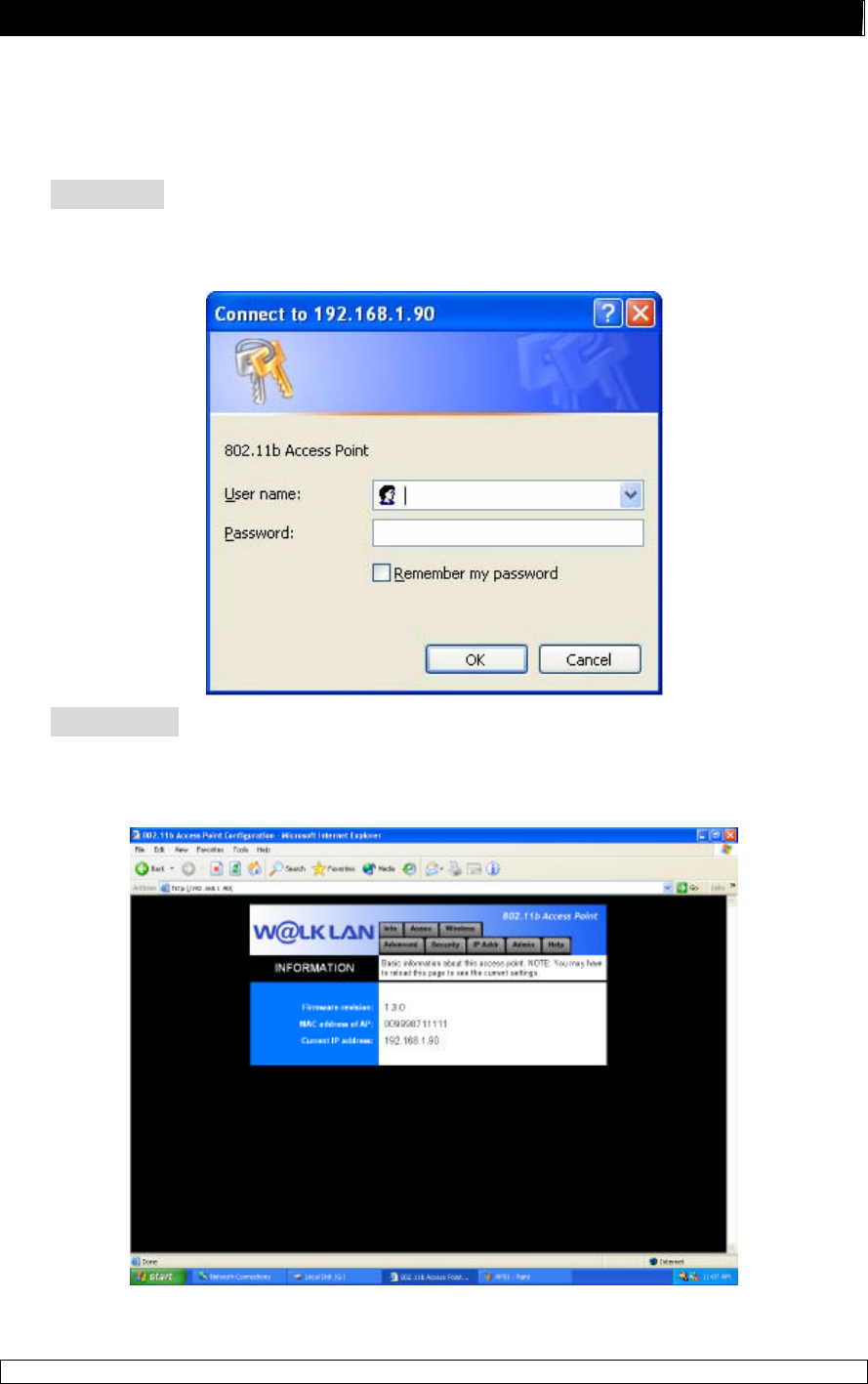
11
6 Configuring Your W@LK LAN AP
The steps below help you configure your W@LK LAN AP on the LAN using the Web GUI.
Launch a web browser (i.e. Internet Explorer or Netscape Navigator) from your computer.
Enter the default URL http://192.168.1.90 and press Enter
1. Password
Enter your User name and Password, or “Enter” to Next Step.
2. Information
By choosing this option, you can view basic information about the Utility like the Firmware
Version, MAC address and current IP address.
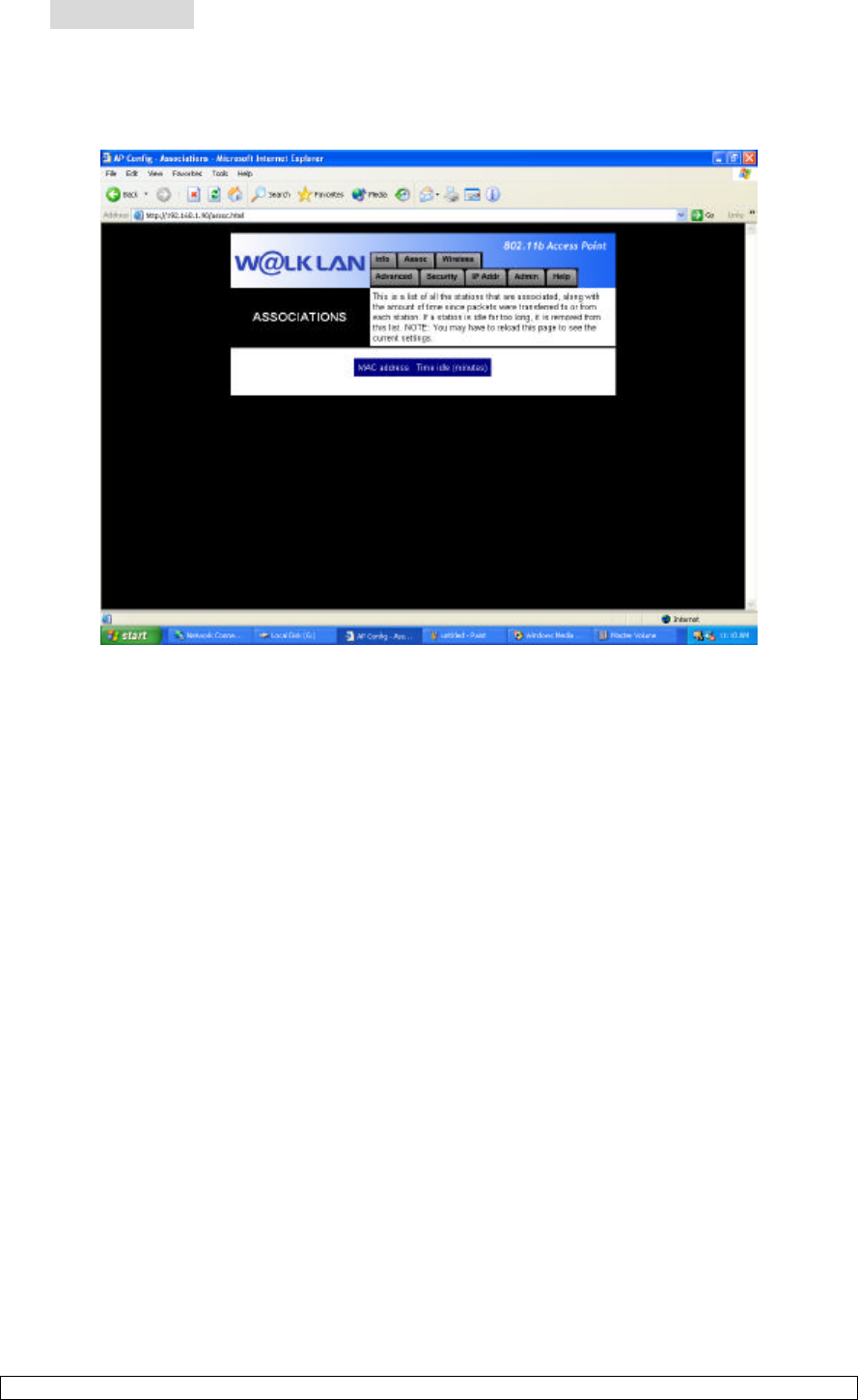
12
3. Associations
This is a list of all the stations that are associated, along with the amount of time since
packets were transferred to or from each station. If a station is idle for too long, It is
removed from this list.
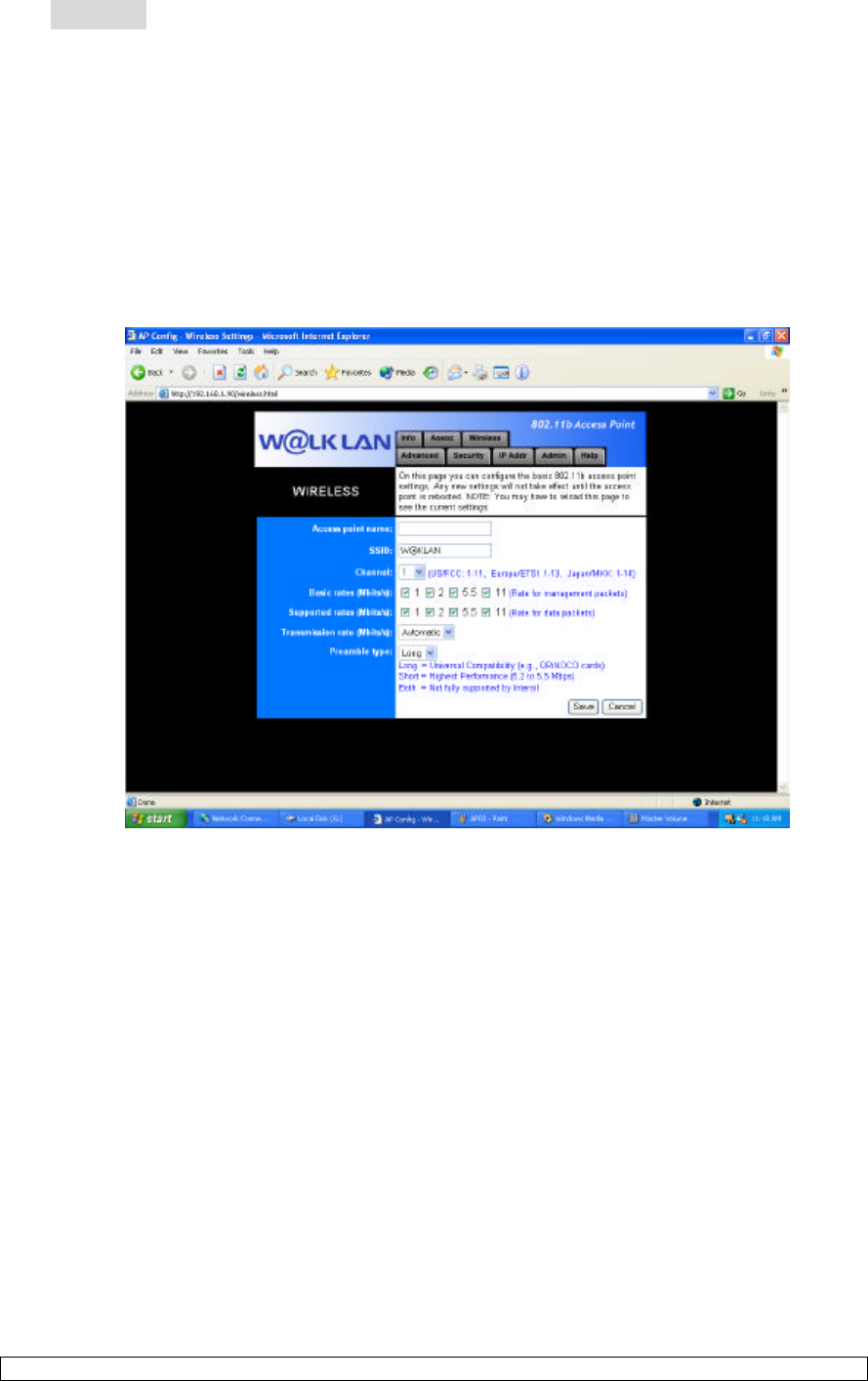
13
4. Wireless
This page allows you to configure the following parameters:
l Access point name
l SSID
l Channel
l Basic rates
l Supported rates
l Transmission rate
l Preamble Type
AP Name
The AP Name is used to help identify an W@LK LAN AP when multiple APs are being used.
For nstance, in a large building using 20 APs, the names may be "AP 1:WEST ROOM", or
in a large house, "AP 5:Kitchen". To enter a name, click in the name field and enter a name.
When finished making changes, click "Save" for the changes to take effect.
SSID
The Service Set Identifier (SSID) is like a name for the wireless network and is sometimes
called the "Network Name". All W@LK LAN APs in a wireless network should be set to the
same SSID to enable clients to roam from W@LK LAN AP to W@LK LAN AP. The
wireless-equipped computers in the wireless network should also be set to the same SSID
to gain access to the network. The default setting is "WLAN" (Wireless Local Area Network).

14
To change the SSID, simply click in the SSID field and enter a new SSID. When finished
making changes, click "Save" for the changes to take effect.
Channel
The 802.11b wireless standard supports up to 14 channels. The number of available
channels are limited to local regulations that determine which channels are available.
(FCC/IC: Channels 1-11; ETSI: Channels 1-13;Japan/MKK: Channels 1-14.)
The default channel is 1. To change the channel, click the UP/DOWN arrows next to the
channel field. When finished making changes, click "Save" for the changes to take effect.
Transmission rate
Select “Automatic” from the drop-down list to optimize the data transfer speed for your
network. (Default: Automatic)
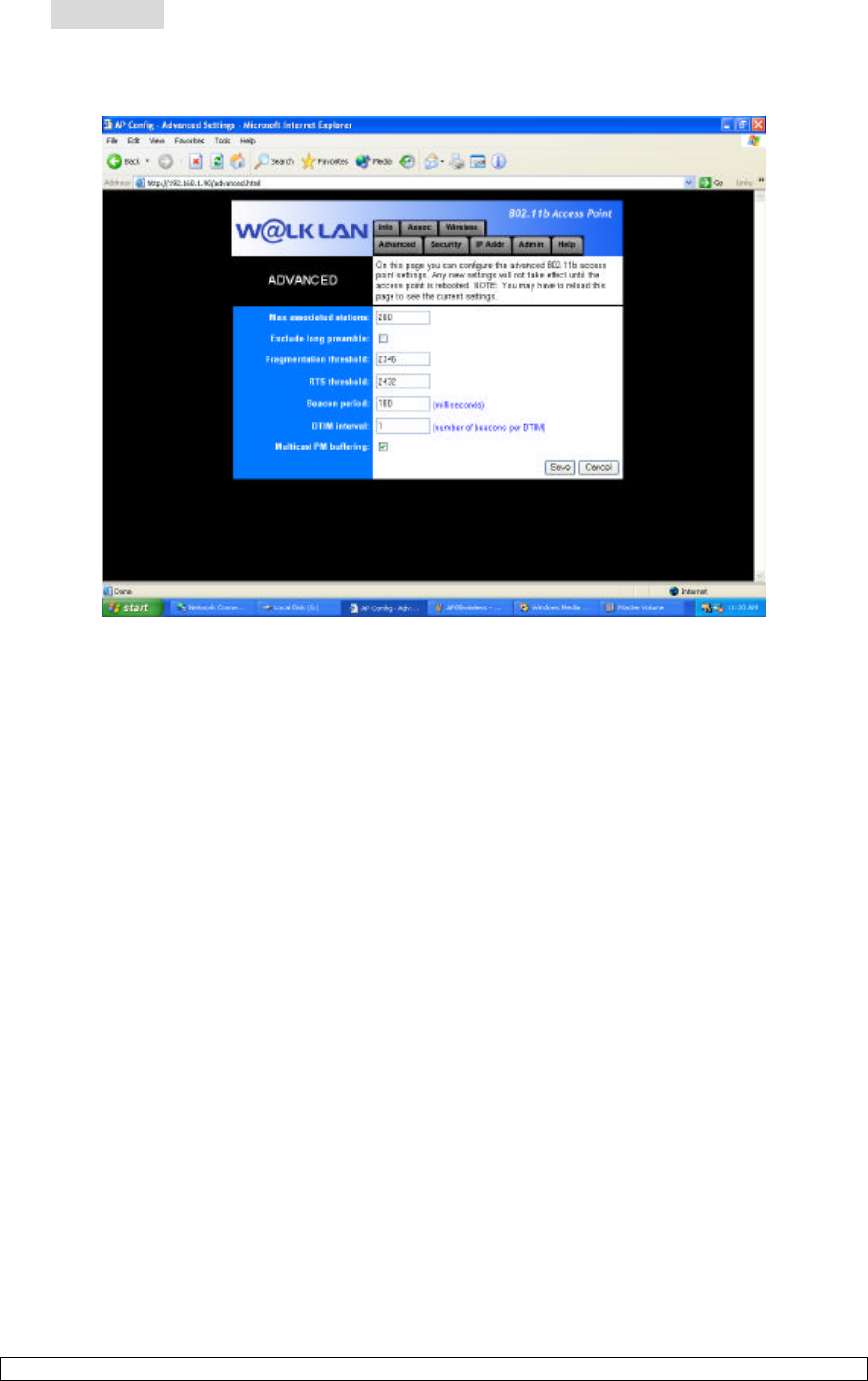
15
5. Advanced
On this page you can configure the advanced 802.11b access point settings. Any new
settings will not take effect until the access point is rebooted.
Max associated stations:
This indicates the number of wireless clients (computers) connected to the W@LK LAN AP.
A total of 64 wireless clients can be connected at a single time.
RTS threshold
This is the rate at which errors are checked. We recommend not changing this.
Beacon period
Set the interval value of beacon between synchronized frames. These synchronous frames
also contain indication of frames that need to transmit to the power-saved stations. (Default:
100)
DTIM interval
Set the Delivery Traffic Indication Message (DTIM) interval value. The DTIM indicates how
often the MAC layer forwards multicast traffic. This parameter is necessary to
accommodate stations using Power Save mode. In order to maximize the utilization of
channels, broadcast data is not transmitted every beacon for stations in Power Save mode.
These power-saved stations must wake up to receive broadcast data at the DTIM interval.
The DTIM is the interval between two synchronous frames with broadcast information. If

16
you set the value to 2, the access point will save all multicast frames for the BSS and
forward them after every second beacon. Having smaller DTIM intervals delivers multicast
frames in a more timely manner, causing stations in Power Save mode to wake up more
often and drain power faster. Having higher DTIM values, though, delays the transmission
of multicast frames. (Default: 1)
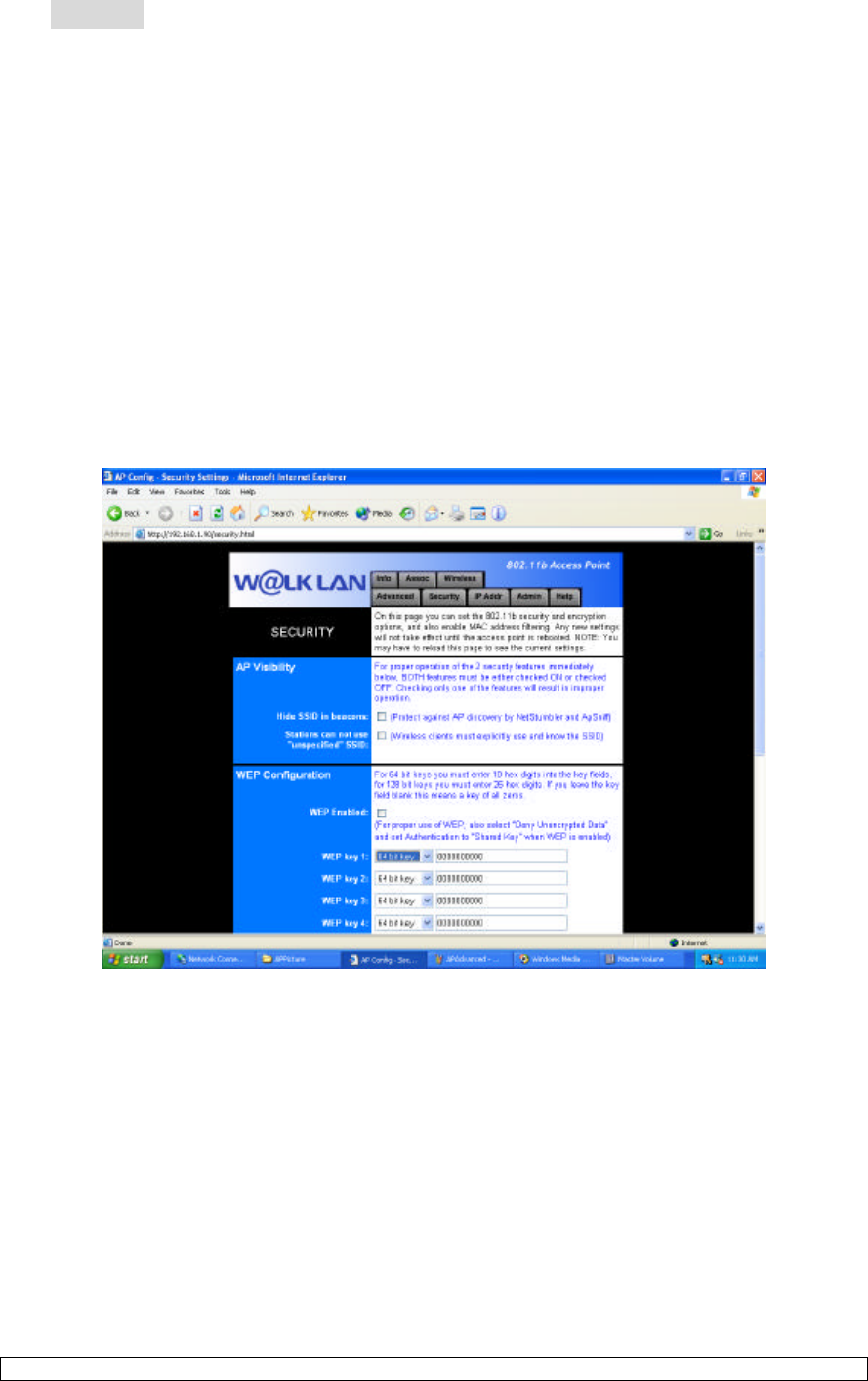
17
6. Security
On this page you can set the 802.11b security and encryption options, and also enable
MAC address filtering. Any new settings will not take effect until the access point is
rebooted.
For secure data transmissions, the W@LK LAN AP is capable of encrypting, or
"scrambling", the information that is sent over the air between your computers. The W@LK
LAN AP uses a form of encryption called WEP (Wired Equivalent Privacy). There are two
levels of WEP encryption—64-bit and 128-bit. As the numbers imply, 128-bit encryption is
more secure than 64-bit encryption. However, using 128-bit encryption can slow down the
rate at which data is sent between the wireless-equipped computers and the W@LK LAN
AP. WEP encryption uses keys to scramble and unscramble the data that is being sent
between wireless-equipped computers and the W@LK LAN AP. The W@LK LAN AP and
the computers must use the same key to be able to communicate using encryption.
WEP Configuration
Wired Equivalent Privacy (WEP) is implemented in this device to prevent unauthorized
access to your wireless network. The WEP setting must be the same on each client in your
wireless network. For more secure data transmission, you may set the WEP to prevent
unauthorized access to your wireless network. (Default: Disable )
WEP key Setup
For more secure data transmission, click on the “Enable” radio button to ensure wireless
network security. Then select one WEP key (1 ~ 4) and the proper key size.
l 64-Bit Manual Entry
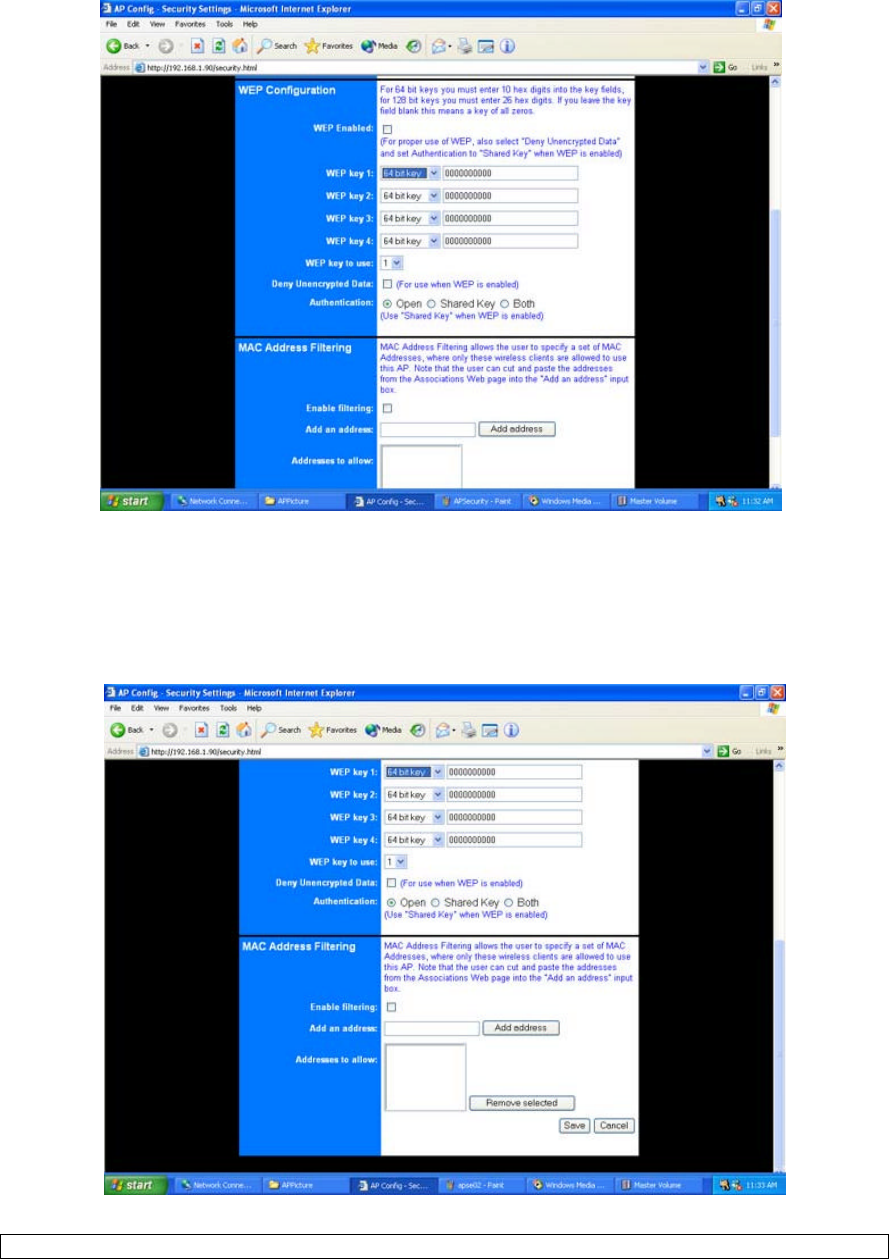
18
Key 1~4 - Each Key ID contains 10 HEX digits. All wireless devices must have
the same Key ID values to communicate.
l 128-Bit Manual Entry
Key ID contains 26 HEX digits. All wireless devices must have the same Key ID
values to communicate.
Wired Equivalent Privacy (WEP) is implemented in this device to prevent unauthorized
access to your wireless network. The WEP setting must be the same on each client in your
wireless network.

19
MAC Address Filtering
The W@LK LAN AP can be programmed with a list of MAC addresses that are allowed to
connect to the W@LK LAN AP. A MAC address is a unique "serial number" that is assigned
to every wireless adapter. For instance, if you own a W@LK LAN F5D6020 Wireless
Notebook Network Adapter for your laptop, it has been assigned its own MAC address at
the factory. The MAC address is located on a small sticker on the bottom of the product.
Programming the W@LK LAN AP with this MAC address and enabling the MAC address
filtering feature lets you manage which computers are allowed to connect to the W@LK
LAN AP.
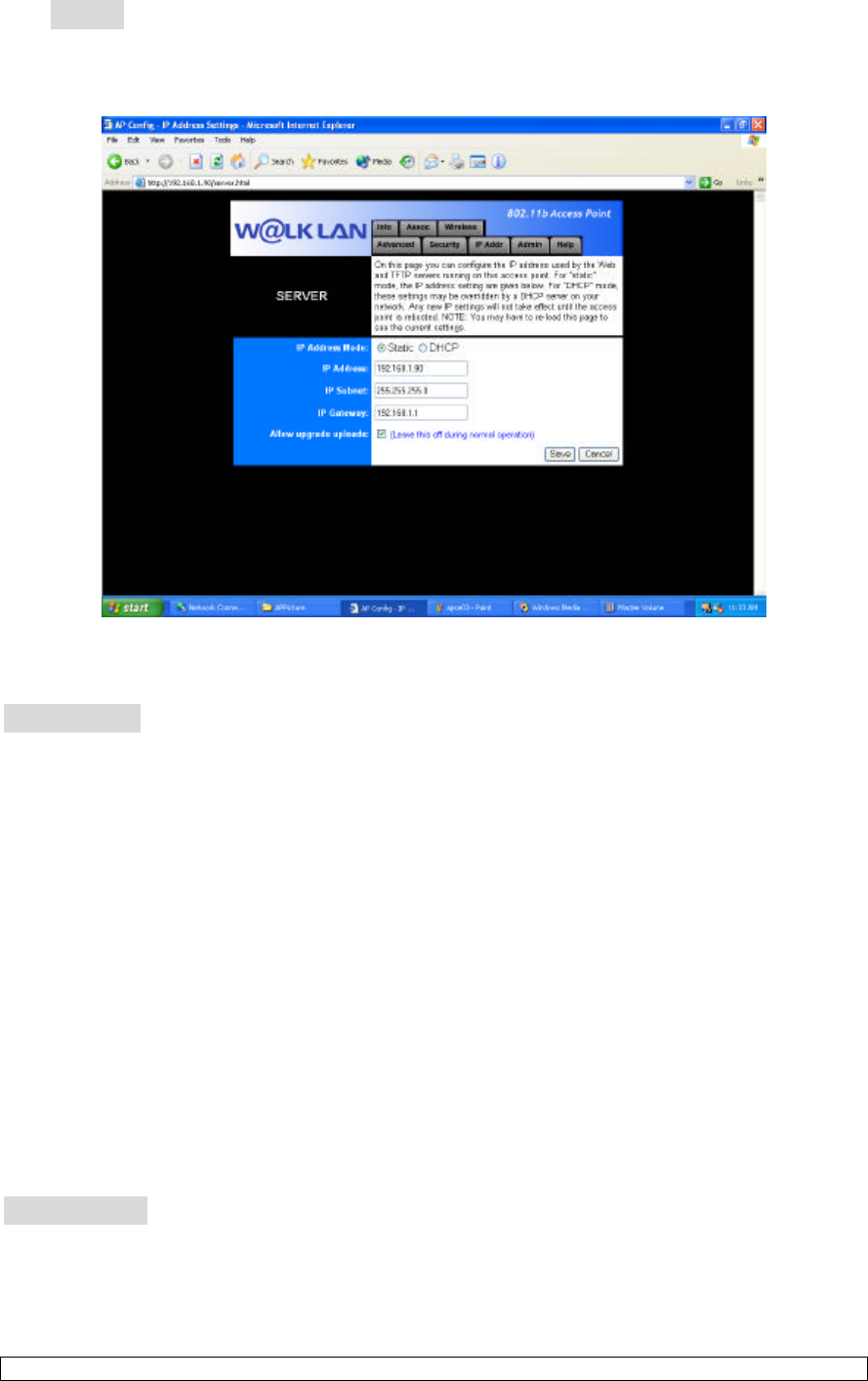
20
7. Server
On this page you can configure the IP address used by the Web and PHCP servers turning
on this access point.
Static Mode:
IP Address
An IP address can be manually entered. The default IP address is 192.168.1.90. To enter
the IP address, click in the “IP Address” field and enter the IP address.
IP Subnet
A Subnet Mask can be manually entered. The default Subnet Mask is 255.255.255.0. To
enter the Subnet Mask, click in the “Subnet Mask” field and enter the Subnet Mask.
IP Gateway
A Default Gateway address can be manually entered. The Default Gateway address is 192.168.1.1.
To enter a Default Gateway address, click in the “Subnet Mask” field and enter the Default Gateway
address.
DHCP Mode:
The W@LK LAN AP can obtain an IP address, Subnet Mask, and Default Gateway
information automatically in a dynamic network environment. The default setting is
"Enabled". If the W@LK LAN AP is connected to a network that does not employ DHCP,

21
the default IP address, Subnet Mask, and Default Gateway will be used. To enable or
disable the DHCP Client, click on the down arrow and select "Enabled" or “Disabled". When
finished making changes, click "Save" for the changes to take effect.
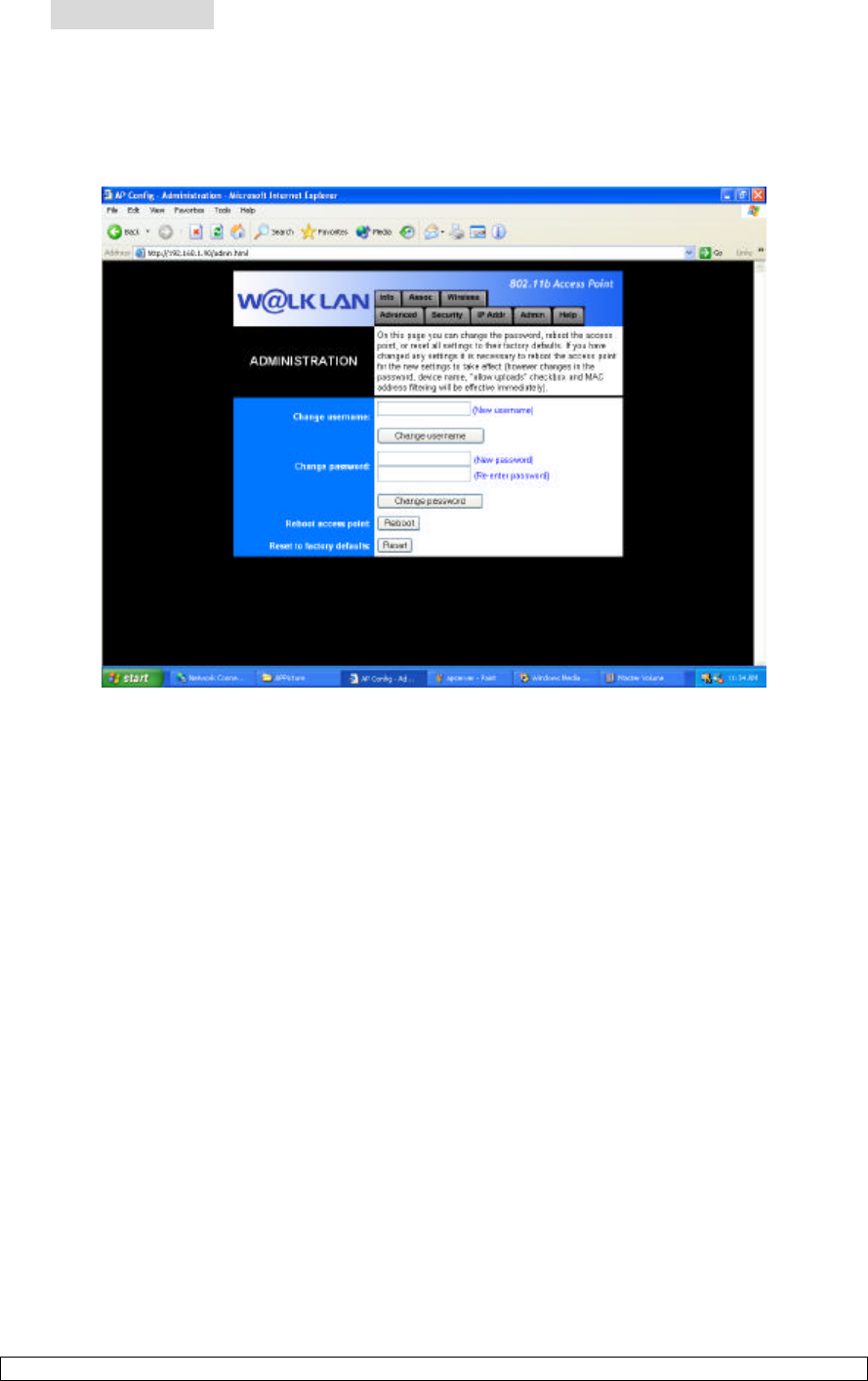
22
8. Administration
On this page you can change the password, reboot the access point, or reset all settings to
their factory defaults. If you have changed any settings it is necessary to reboot the access
point for new settings to take effect. (however changes in the password, device name.
“allow uploads” checkbox and MAX address filtering will be effective immediately).
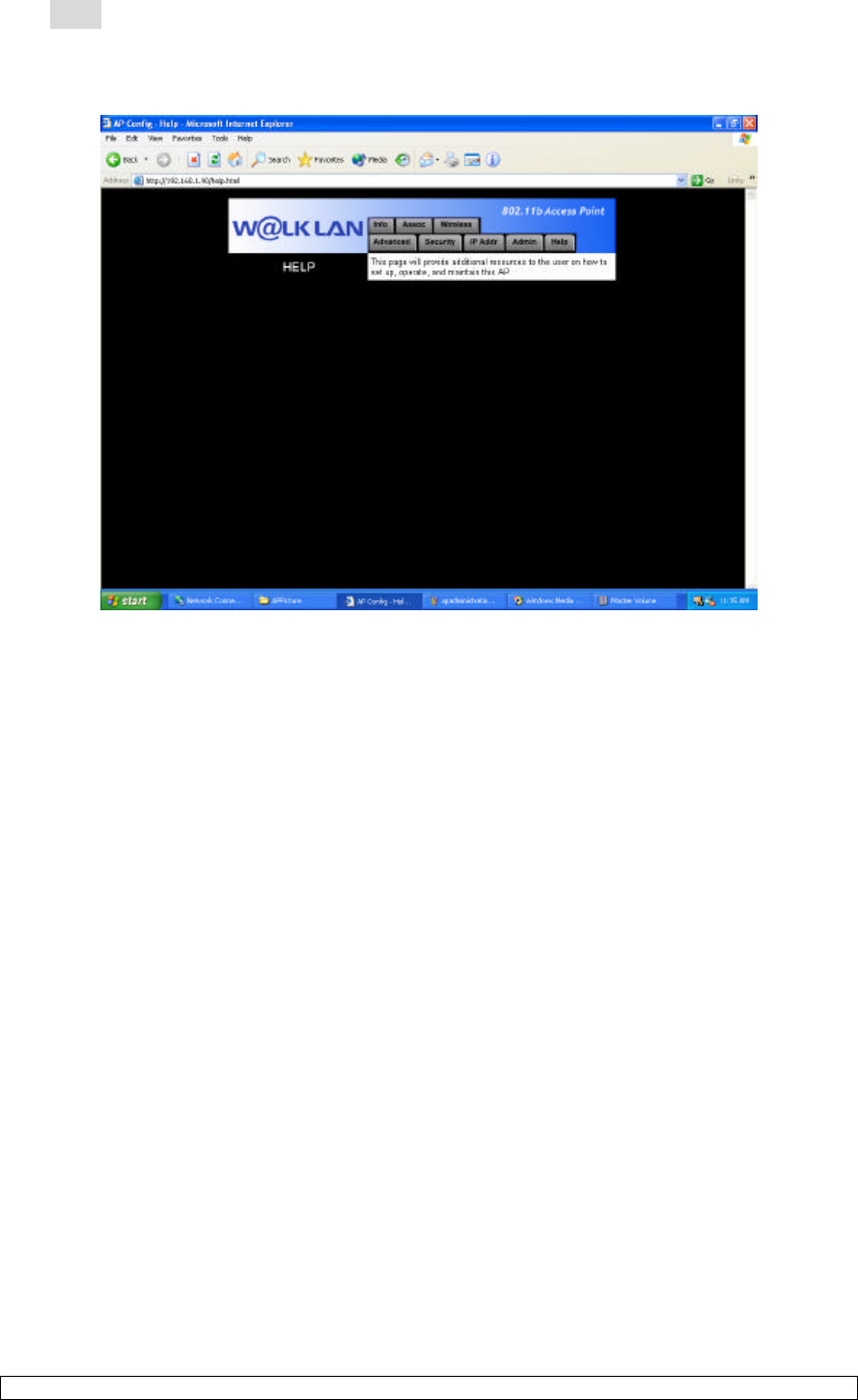
23
9. Help
This page will provide additional resources to the user on how to set up, operate, and
maintain this AP.
Troubleshooting

24
7 Troubleshooting
Problem Solution
Wireless users (clients) do not
have access to the network
through the W@LK LAN AP.
l Make sure that each wireless cl
ient is configured to
the same encryption setting.
l
Make sure that each wireless client is configured to
connect to the SSID of the W@LK LAN AP
The range is poor l See “Selecting an Appropriate Site for your
Wireless Access Point” in the “Installation” section
of this manual.
Plexuscom Inc
560 S.Winchester Blvd,Suite 303,San Jose,CA 95128
TEL:408-236-7603,408-236-7648
FAX:408-236-7641